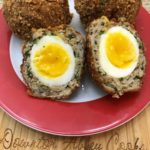The History of Scotch Eggs
Scotch eggs first appeared in Britain in the early 19th century. They were created by the famous luxury food shop Fortnum & Mason in London, though their exact origins are disputed. The earliest published recipe comes from the 1829 cookbook “The Cook and Housewife’s Manual” by Mistress Margaret Dods.
Originally, Scotch eggs were served hot with gravy as part of an upper class Victorian dinner. Famed cookbook author Mrs. Beeton included recipes for them in her influential “Book of Household Management” (1861). Over time, the dish evolved into a cold snack or appetizer often paired with cheeses and pickled onions in pubs.
The rich flavors and textures have made Scotch eggs a staple pub food in the UK for over a century. As you celebrate the start of the new year, enjoy this classic appetizer for a taste of Britain. The unique contrast of crispy breaded exterior and soft boiled egg makes them the perfect treat for New Year’s festivities.
Scotch Eggs is the Perfect Pub Snack
Ingredients
- 5 large eggs
- 4 uncooked quality pork sausages
- 1/4 cup fresh chives, chopped
- 1/4 cup Fresh flat-leaf parsley
- 1/4 cup unbleached flour for dusting
- 1 cup seasoned breadcrumbs
- 6 cups vegetable oil
Instructions
- Place 4 of the eggs into a pot filled with cold water, then bring to a boil. Boil for 3 to 4 minutes, then move to a bowl of cold water to cool. Peel once they have cooled and put aside.
- Cut open the sausage casings and squeeze the sausage meat out into a bowl. Add the herbs, season with salt and freshly ground pepper. Get your hands in there and mix so all the ingredients are well incorporated. Then form into 4 equal balls.
- Set up up an assembly line. start with your meat balls, then one flat container with the flour, one with the remaining egg (beaten), one with the crumbs. At the end of the line place a large plate.
- Lightly flour your hands so they won't be sticky. Place one of the balls in the palm of on your hands, then flatten.
- Roll a peeled egg in flour, then bring the sides of the meat around the egg and seal.
- Roll the egg in the flour, then the beaten egg, followed by the crumbs. Repeat the egg wash and crumbs which will give you a a nice coating. Place on the plate and repeat with the other 3 eggs.
- Heat the oil in a heavy deep pot or deep fat fryer to about 150ºC/300ºF. Use a instant read thermometer to check the temperature if you are using a pot. Have a heat proof plate layered with paper towels at the ready to place your completed
- Using a metal slotted spoon, lower 1 or 2 eggs into the pot, cooking until golden, rotating occasionally if your eggs touch the bottom of the pot. Cooking should take 3 or 4 minutes. Remove with a slotted spoon and drain on your plate with paper towels.
- You can enjoy the scotch eggs warm or cold. Serve with cheese
